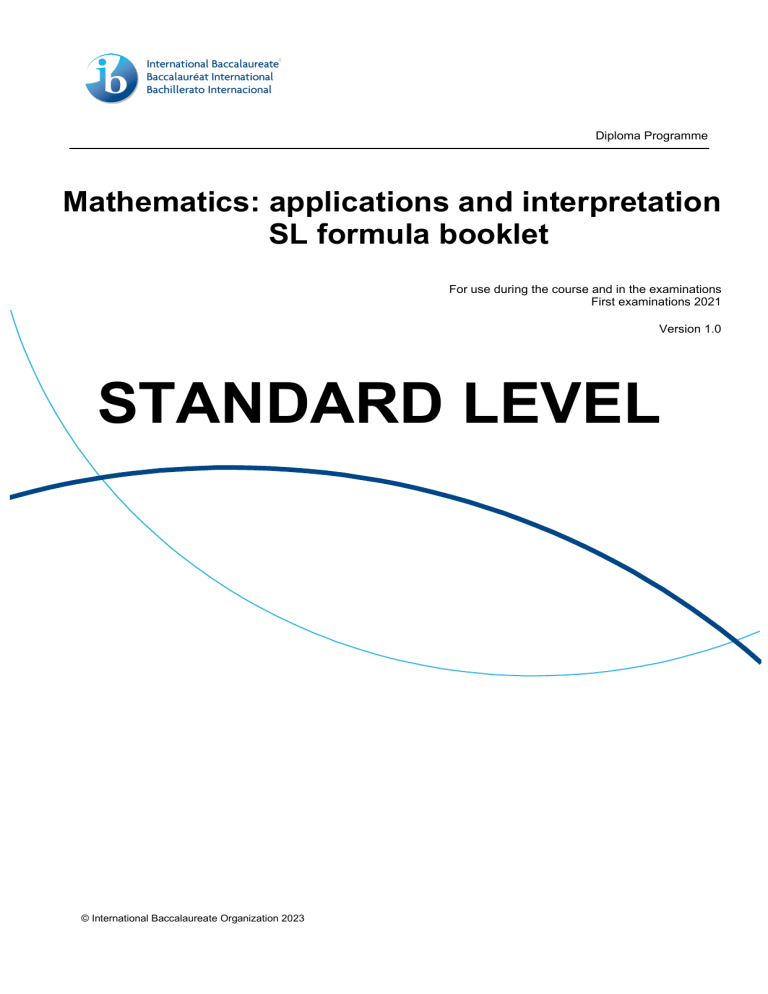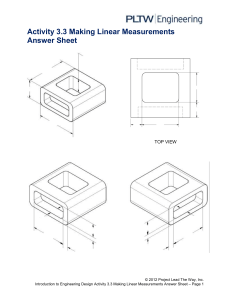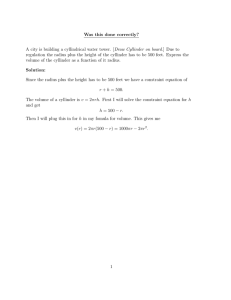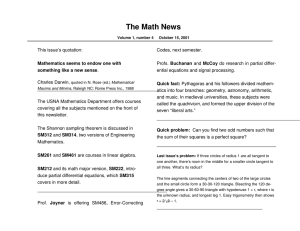
Diploma Programme Mathematics: applications and interpretation SL formula booklet For use during the course and in the examinations First examinations 2021 Version 1.0 STANDARD LEVEL © International Baccalaureate Organization 2023 Contents Topic 1: Number and algebra – SL 2 Topic 2: Functions – SL 2 Topic 3: Geometry and trigonometry – SL 3 Topic 4: Statistics and probability – SL 5 Topic 5: Calculus – SL 6 Topic 1: Number and algebra – SL 1.2 1.3 The nth term of an arithmetic sequence un = u1 + (n − 1) d The sum of n terms of an arithmetic sequence S n= The nth term of a geometric sequence un = u1r n −1 n n ( 2u1 + (n − 1) d ) ; Sn= (u1 + un ) 2 2 u1 (r n − 1) u1 (1 − r n ) The sum of n terms of a , r ≠1 = Sn = finite geometric sequence r −1 1− r 1.4 Compound interest r FV = PV × 1 + , where FV is the future value, 100k PV is the present value, n is the number of years, k is the number of compounding periods per year, r% is the nominal annual rate of interest 1.5 Exponents and logarithms a x = b ⇔ x = log a b , where a > 0, b > 0, a ≠ 1 Percentage error ε= 1.6 kn vA − vE × 100% , where vE is the exact value and vA is vE the approximate value of v Topic 2: Functions – SL 2.1 2.5 Equations of a straight line = 0 ; y − y1= m ( x − x1 ) y mx + c ; ax + by + d = y2 − y1 x2 − x1 Gradient formula m= Axis of symmetry of the graph of a quadratic function f ( x) = ax 2 + bx + c ⇒ axis of symmetry is x = − Mathematics: applications and interpretation SL formula booklet b 2a 2 Topic 3: Geometry and trigonometry – SL Prior learning – SL Area of a parallelogram A = bh , where b is the base, h is the height Area of a triangle 1 A = (bh) , where b is the base, h is the height 2 Area of a trapezoid = A 1 (a + b) h , where a and b are the parallel sides, h is the height 2 Area of a circle A = πr 2 , where r is the radius Circumference of a circle C = 2πr , where r is the radius Volume of a cuboid V = lwh , where l is the length, w is the width, h is the height Volume of a cylinder V = πr 2 h , where r is the radius, h is the height Volume of prism V = Ah , where A is the area of cross-section, h is the height Area of the curved surface of a cylinder A= 2πrh , where r is the radius, h is the height Distance between two points ( x1 , y1 ) and ( x2 , y2 ) d= Coordinates of the midpoint of a line segment with endpoints ( x1 , y1 ) and ( x2 , y2 ) x1 + x2 y1 + y2 , 2 2 3.1 ( x1 − x2 ) 2 + ( y1 − y2 ) 2 Distance between two points ( x1 , y1 , z1 ) and d= Coordinates of the midpoint of a line segment with endpoints ( x1 , y1 , z1 ) x1 + x2 y1 + y2 z1 + z2 , , 2 2 2 ( x1 − x2 ) 2 + ( y1 − y2 ) 2 + ( z1 − z2 ) 2 ( x2 , y2 , z2 ) and ( x2 , y2 , z2 ) Mathematics: applications and interpretation SL formula booklet 3 3.2 3.4 Volume of a right-pyramid V= 1 Ah , where A is the area of the base, h is the height 3 Volume of a right cone V= 1 2 πr h , where r is the radius, h is the height 3 Area of the curved surface of a cone A = πrl , where r is the radius, l is the slant height Volume of a sphere V= Surface area of a sphere A = 4πr 2 , where r is the radius Sine rule a b c = = sin A sin B sin C Cosine rule c 2 = a 2 + b 2 − 2ab cos C ; cos C = Area of a triangle 1 A = ab sin C 2 Length of an arc = l 4 3 πr , where r is the radius 3 θ 360 a 2 + b2 − c2 2ab × 2πr , where θ is the angle measured in degrees, r is the radius Area of a sector = A θ 360 × πr 2 , where θ is the angle measured in degrees, r is the radius Mathematics: applications and interpretation SL formula booklet 4 Topic 4: Statistics and probability – SL 4.2 Interquartile range IQR = Q3 − Q1 4.3 k Mean, x , of a set of data 4.5 4.6 4.7 4.8 x= ∑fx i =1 i i , where n = n k ∑f i =1 i n ( A) n (U ) Probability of an event A P ( A) = Complementary events P ( A) + P ( A′) = 1 Combined events P ( A ∪ B )= P ( A) + P ( B) − P ( A ∩ B) Mutually exclusive events P ( A ∪ B )= P ( A) + P ( B) Conditional probability P ( A B) = Independent events P ( A ∩ B) = P ( A) P ( B) Expected value of a E(X ) discrete random variable X= P ( A ∩ B) P ( B) k x P(X ∑= i =1 i xi ) Binomial distribution X ~ B (n , p) Mean E ( X ) = np Variance Var (= X ) np (1 − p ) Mathematics: applications and interpretation SL formula booklet 5 Topic 5: Calculus – SL 5.3 5.5 Derivative of x n f ( x) = x n ⇒ f ′( x) = nx n −1 Integral of x n n dx ∫x= Area of region enclosed by a curve y = f ( x) and the A = ∫ y dx x n +1 + C , n ≠ −1 n +1 b a x-axis, where f ( x) > 0 5.8 The trapezoidal rule 1 y dx ≈ h ( ( y0 + yn ) + 2( y1 + y2 + ... + yn −1 ) ) , 2 b−a where h = n ∫ b a Mathematics: applications and interpretation SL formula booklet 6



